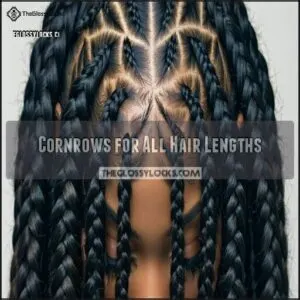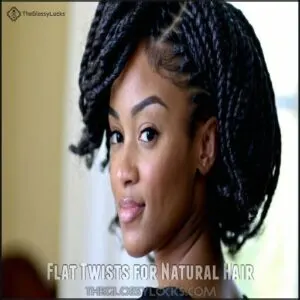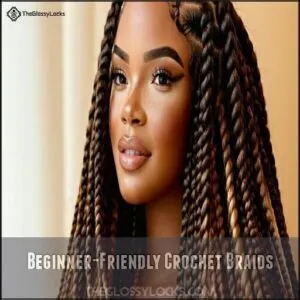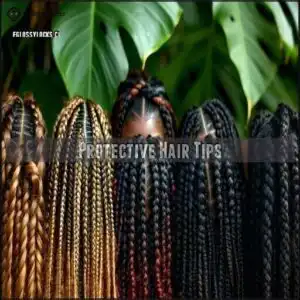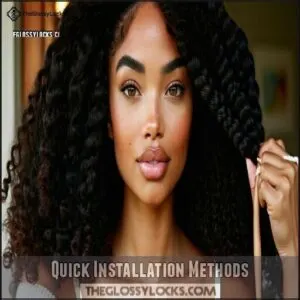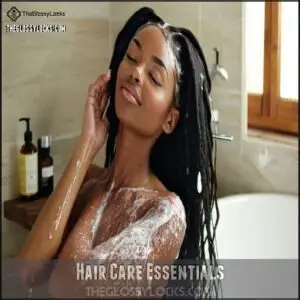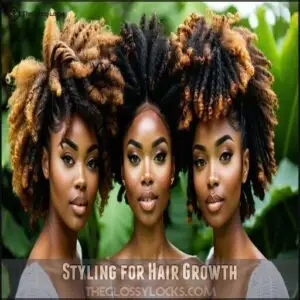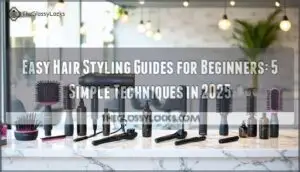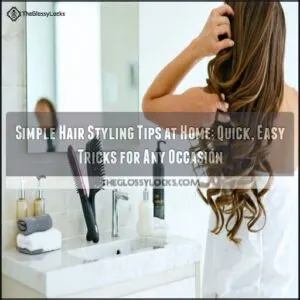This site is supported by our readers. We may earn a commission, at no cost to you, if you purchase through links.
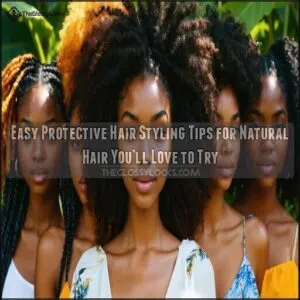
Try beginner-friendly options like cornrows, flat twists, or mini twists—they’re simple and work for any hair length.
If you want a quick transformation, crochet braids are a game-changer.
To reduce breakage, don’t over-manipulate your hair and prep it with a good pre-poo or co-wash.
Deep conditioning before styling locks in moisture, keeping tangles at bay.
Styles like bantu knots or flat twists also protect and promote hair growth.
Experiment with versatile options to match your mood, and you’ll never run out of ideas to keep your hair healthy.
Table Of Contents
- Key Takeaways
- Easy Protective Styles
- Protective Hair Tips
- Simple Hair Styling
- Hair Care Essentials
- Styling for Hair Growth
- Frequently Asked Questions (FAQs)
- What is the easiest protective hairstyle to do?
- How do I prepare my hair for a protective style?
- How do I make my hair grow in protective style?
- What is the least damaging protective hair style?
- How do I safely remove protective styles?
- What products prevent scalp dryness with braids?
- Can protective styles damage hairlines over time?
- How often should I moisturize in styles?
- Are protective styles suitable for thinning edges?
- Conclusion
Key Takeaways
- Keep your hair moisturized with regular deep conditioning and lightweight leave-ins to prevent breakage.
- Choose low-tension protective styles like flat twists or knotless braids to protect your edges and scalp.
- Prep your hair before styling by washing, detangling, and applying leave-in conditioner or oil for moisture retention.
- Maintain your protective style by moisturizing every 2–3 days, using a satin scarf at night, and avoiding excessive tension.
Easy Protective Styles
Protective styles like cornrows, flat twists, and crochet braids keep your natural hair secure while minimizing daily upkeep.
These easy options reduce breakage, saving you time and preserving the health of your hair.
Cornrows for All Hair Lengths
Cornrows are a go-to protective hairstyle for all hair lengths, offering styling options like side-parts and sunburst patterns.
Cornrows are versatile, low-maintenance, and perfect for protecting your hair while offering endless styling possibilities for any occasion.
They promote scalp health by reducing manipulation and tucking ends away. For cornrow longevity, maintain moisture and avoid tight braids to protect edges.
Cornrows can also provide benefits as a protective style.
These low-manipulation styles balance hair protection with versatility, making them perfect for easy hair styling and daily wear.
Flat Twists for Natural Hair
Flat twists are fantastic protective hairstyles that work for all hair lengths and offer incredible styling versatility.
These low manipulation styles reduce tension on your edges while keeping your natural hair moisturized and tangle-free.
You can find the right products online to help achieve the perfect style.
Twist variations can create looks like halos or buns, and with minimal maintenance tips, they stay neat, making them one of the easiest protective styles to try.
Beginner-Friendly Crochet Braids
Crochet braids are a beginner-friendly hairstyle offering quick installation and endless styling versatility. They’re cost-effective, work with or without cornrows, and pair well with hair extensions for a fuller look.
Crochet braids are versatile, easy to install, and perfect for beginners seeking stylish, cost-effective protective hairstyles.
To find the right materials, consider purchasing crochet hair.
Here’s how to make them shine:
- Choose pre-looped crochet hair types.
- Moisturize scalp regularly.
- Sleep with a satin scarf.
- Keep styles light to avoid braid slipping.
- Clip stray fibers for polish.
Protective Hair Tips
You can keep your natural hair healthy and manageable by reducing daily manipulation, which helps prevent stress on your strands.
Focus on styles that minimize tangles and breakage while promoting overall growth and strength.
Reducing Hair Manipulation
Protective hairstyles like box braids or flat twists help reduce hair manipulation and promote style longevity.
Focus on gentle detangling using a wide-tooth comb and limit product overload for scalp health.
Low manipulation styling keeps your routine simple while reducing breakage risk. Protect your hair at night with satin bonnets or silk pillowcases to maintain moisture and avoid friction.
Minimizing Tangles and Breakage
Keeping tangles and breakage at bay is essential for healthy hair.
Here’s how:
- Use gentle detangling tools to prevent damage.
- Protect your hair at night with a satin scarf or bonnet.
- Maintain moisture balance using hydrating products and regular deep conditioning.
- Trim regularly to remove split ends and support protective hairstyles, promoting low manipulation and moisture retention.
Promoting Hair Growth
Boosting hair growth starts with scalp health. Massage techniques improve circulation, while growth oils lock in moisture and fight hair breakage.
Stay hydrated and include nutrient-rich foods in your diet to fuel growth from within. Protective hairstyles guard against damage and support moisture retention.
Focus on these essentials:
| Tip | Benefits | How-to |
|---|---|---|
| Scalp massages | Improves blood flow | Use fingertips or massage tools daily |
| Growth oils | Moisture retention, scalp health | Apply weekly for deep conditioning |
| Nutrient-rich diet | Supports hair growth | Eat biotin, omega-3, and zinc-rich foods |
The key to successful hair growth is maintaining a healthy scalp and using the right techniques, such as scalp massages and applying growth oils. By following these steps and incorporating protective hairstyles into your routine, you can promote hair growth and reduce breakage.
Simple Hair Styling
You can make protective styling effortless with quick installation techniques that save time while maintaining hair health.
Choosing low-maintenance options guarantees your natural hair stays protected, allowing you to focus on versatile styles that suit any occasion.
Quick Installation Methods
Save time with easy protective styles like pre-styled hair and simplified sectioning techniques.
Tools like crochet hooks allow for quick styling, making it beginner-friendly.
Opt for minimal braiding methods to create protective hairstyles efficiently.
Timesaving options like jumbo twists or drawstring ponytails cut down styling time while delivering fabulous looks.
Perfect for professionals or anyone short on time!
Low-Maintenance Styles
Low-maintenance styles like box braids or twist styles are perfect for keeping your day easy.
They guarantee scalp health while offering style longevity when paired with protective styling tips, like staying consistent with your night routine and refresh methods.
Use lightweight products to reduce buildup and maintain a neat look.
These easy protective styles minimize effort while protecting hair from damage.
To keep your hair healthy, remember the importance of hydration.
Versatile Styling Options
Exploring versatile styling options opens up endless possibilities for easy protective styles.
Updo variations, braid transformations, and twist techniques can create stunning looks quickly.
Wig styling and extension looks also deliver unmatched hair versatility while safeguarding strands.
Protective styling tips focus on practical hair protection strategies, ensuring every style complements your routine while keeping your hair healthy and stylish.
Hair Care Essentials
You’ll need to prioritize pre-pooing, co-washing, and deep conditioning to guarantee your natural hair stays healthy and moisturized.
These steps protect your strands, reduce breakage, and set a solid foundation for any protective style.
Pre-Pooing and Co-Washing
Start with natural oils or conditioners as your pre-poo ingredients to shield your strands before washing.
Co-wash frequency varies; aim for weekly to manage moisture balance.
Co-washing helps clear lightweight product buildup while maintaining scalp health.
For effective hair maintenance, pre-pooing reduces hair breakage, boosts protective styling tips, and guarantees a foundation for long-term hair health. Many people use specialized products beforehand to protect their hair.
Deep Conditioning for Hair Health
Deep conditioning is essential for hair health, boosting moisture retention and preventing breakage. Use a conditioner with ingredients like shea butter or argan oil for best results.
Apply after shampooing, focusing on ends and scalp. Rinse thoroughly.
- Look for deep conditioner types suited to your hair’s needs.
- Follow proper application techniques to lock in hydration.
- As a bonus, it also improves hair shine.
- Maintain scalp health with regular use, which is crucial for overall hair health and can lead to better results.
Weekly Hair Care Routines
Shifting from deep conditioning, weekly hair care routines emphasize healthy hair and scalp care without overwhelming your schedule.
| Focus | Tips |
|---|---|
| Routine Time Investment | Allocate 30–60 minutes weekly. |
| Product Application Frequency | Follow label instructions strictly. |
| Overnight Protection | Use a satin bonnet or silk scarf. |
| DIY Treatment Schedules | Plan hydration treatments regularly. |
Stay consistent; balance hydration method variety and proper scalp health focus to achieve proper scalp health and maintain overall hair care.
Styling for Hair Growth
Protective styles like flat twists, bantu knots, and loc retwists help safeguard your hair, reducing breakage and retaining length.
By keeping hair moisturized and minimizing manipulation, these techniques promote healthier growth over time.
Flat Twist Benefits for Hair
Flat twists are game-changers for your hair. They offer gentle scalp tension relief, protect strands, and promote length retention.
Perfect for growth-focused care, they lock in moisture while preventing hair breakage. Plus, flat twists give you endless style versatility, from casual to chic.
- Lightweight and scalp-friendly
- Easy protective styles for any occasion
- Prevents damage while promoting growth
- Maintains moisture for healthier hair
Bantu Knots for Moisture Retention
Bantu knots are perfect for locking in moisture while preventing hair breakage.
Adjust knot size based on styling variations and your hair porosity. Use rich creams or oils for product pairing, ensuring scalp health and length retention.
These easy protective styles preserve hair moisture and add flair to your routine, making them a go-to for hair growth.
Loc Retwist for Hair Health
Locs thrive with proper care, and retwisting is key to keeping them neat and healthy.
Focus on a comfortable Retwist Frequency to avoid scalp damage or thinning. Choose nourishing products like aloe vera gel for better hold. Use proper Tension Control to protect roots and promote Scalp Health.
Over-retwisting can lead to hair breakage issues.
Simple tips include:
- Wash locs well beforehand.
- Moisturize to prevent dryness.
- Use clips for precision.
- Avoid overwashing for Style Longevity.
Frequently Asked Questions (FAQs)
What is the easiest protective hairstyle to do?
If you’ve ever felt like managing your hair is a marathon, try two-strand twists.
They’re simple, quick, and perfect for any hair type.
Just twist, moisturize, and let your natural beauty shine!
How do I prepare my hair for a protective style?
Start with clean, moisturized hair—wash, deep condition, and detangle thoroughly.
Trim damaged ends, stretch your hair to minimize tension.
Apply a leave-in conditioner or oil for moisture retention before installing your protective style.
How do I make my hair grow in protective style?
Think of your hair as a tree; it thrives with constant care.
Moisturize your scalp weekly, avoid excessive tension, cleanse buildup with gentle shampoos.
And protect edges at night with satin or silk scarves, to ensure the constant care needed for healthy hair growth.
What is the least damaging protective hair style?
Go for low-tension styles like knotless braids, two-strand twists, or flat twists.
They protect your hair without stressing the scalp, reduce breakage, and let your natural hair thrive while still looking fabulous and polished.
How do I safely remove protective styles?
Removing protective styles is like untangling a story—take it slow.
Use oil or conditioner to loosen tension, gently detangle sections with fingers or a wide-tooth comb, and avoid pulling to protect your hair’s integrity.
What products prevent scalp dryness with braids?
Keep your scalp hydrated with lightweight oils like jojoba or tea tree oil.
Use a moisturizing spray or leave-in conditioner to soothe itchiness, and don’t forget to cleanse regularly with a mild, sulfate-free shampoo.
Can protective styles damage hairlines over time?
Over 60% of people experience receding hairlines from tension styles.
Too-tight braids or neglecting care can harm edges.
Loosen styles, moisturize edges, and limit long-term use to keep your hairline healthy and intact.
How often should I moisturize in styles?
Moisturize every 2-3 days with a lightweight, water-based leave-in or moisturizing spray. Focus on roots, scalp, and ends to keep your hair hydrated without buildup, especially in tightly-installed protective styles.
Are protective styles suitable for thinning edges?
Thinning edges can feel like walking on eggshells, but yes, protective styles can help.
Opt for low-tension styles like knotless braids or two-strand twists, and use lightweight products to avoid additional strain on your scalp.
Conclusion
Achieving healthy, thriving hair can feel like discovering a treasure chest of secrets, but easy protective hair styling tips make it simple.
From low-maintenance cornrows to versatile flat twists or crochet braids, you’ve got plenty of options to keep your hair protected and stylish.
Remember to minimize manipulation, prep with pre-poo or co-wash, and deep condition regularly to lock in moisture and reduce tangles.
Consistent care guarantees your natural hair stays strong and ready to grow.

